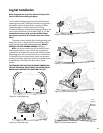
20
Close
Open
Optional Wall Thermostat or
Remote Control
Use only a 750 millivolt DC two-wire circuit thermostat
with this appliance. The thermostat should be placed in
the same room as the heater, typically 5 feet off the
floor. Avoid drafty areas or any area that may affect the
accuracy of the thermostat.
The thermostat should be connected to the GF 400
DV Sebago using a minimum of 16 gauge wire with a
maximum length of 25 feet of wire.
Connect the two thermostat wire leads to the two
lower terminals on the terminal block located directly
above the ignitor button. Do not overtighten the
connections. IT IS NOT NECESSARY TO DISCONNECT
ANY OTHER WIRES. See Fig. 30.
For thermostatic operation, the On/Off/T-Stat
switch on the back of the stove must be in the T-stat
position, and the pilot light must be running, as it is the
power source for the thermostat.
At the thermostat, the two wires should be con-
nected to the two connection screws on the thermostat
base plate per the manufacturer’s instructions.
Remote Control
When using a remote, the remote receiver should be
wired to the terminal block the same way the thermo-
stat would be. See the instructions above.
Follow the operating instructions included with the
Remote Control unit.
CAUTION:
LABEL ALL WIRES PRIOR TO DISCONNECTION
WHEN SERVICING THE CONTROLS. WIRING
ERRORS CAN CAUSE IMPROPER OR DANGEROUS
OPERATION. ALWAYS VERIFY PROPER OPERA-
TION AFTER SERVICING THE APPLIANCE.
Figure 30. Accessory wiring diagram.
Flame Appearance / Air Shutter
Adjustment
The GF 400 DV Sebago gas stove is shipped from the
factory equipped to burn Natural gas with the air shutter
set at the halfway position. Please be aware, however,
that this initial setting may not provide the optimal flame
picture in your particular installation. No single setting
will be appropriate for all vent configurations, fuel types,
or installation environments. The air shutter setting can
also be adjusted to achieve the desired flame appearance.
Flame appearance is a matter of individual preference,
however, most people enjoy a warm yellowish flame.
Too much air - the appliance will generate a flame
that is blue and transparent, or an “anemic” flame.
Too little air - the appliance may generate very long
yellow flames resulting in soot. Sooting produces black
deposits on the logs, on the inside walls of the appliance,
and potentially, on the exterior termination cap. Sooting
is caused by incomplete combustion and lack of combus-
tion air entering the air shutter opening.
To adjust the air shutter: CAUTION! USE WORKGLOVES.
SURFACES MAY BE HOT!
1. Reach under the right side of the stove and loosen the
wingnut located closest to you. See fig. 29. Slide the
wingnut stem forward to open the air shutter and
increase air. Slide the shutter stem back to decrease
the air supply.
2. Tighten the wingnut to secure the shutter at the
desired setting.
3. Operate the burner for 30 minutes on the HIGH setting,
observing the flame continuously. If the flame appears
weak, slow, or sooty, adjust the air shutter to a more
open position as described above until the flame is as
desired. Make adjustments in small increments and
allow the burner to settle in before making further
adjustment
WARNING: AIR SHUTTER ADJUSTMENTS SHOULD ONLY
BE PERFORMED BY A QUALIFIED PROFESSIONAL SERVICE
TECHNICIAN.
Figure 29.
Loosen the wingnut to adjust the air shutter stem.
FRONT
LEG
BACK
LEG
TERMINAL
BLOCK
VALVE
THERMOPILE
OPTIONAL
THERMOSTAT
or
REMOTE
CONTROL
TH
TP
TH
TP
ROCKER
SWITCH
ON
OFF
STAT


















